2014 Cook Islands Silver $10 Galileo Galilei Anniversary PF70 UC NGC Coin
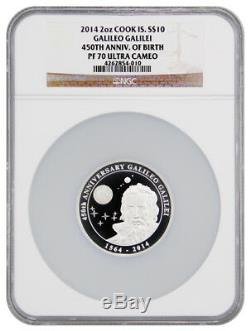
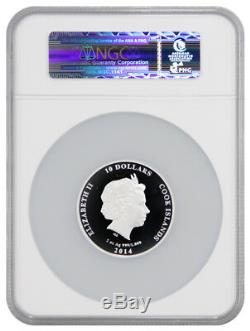
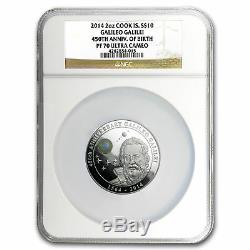


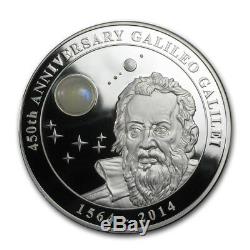
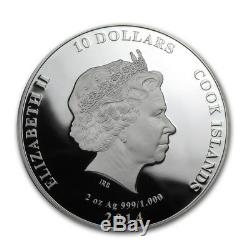
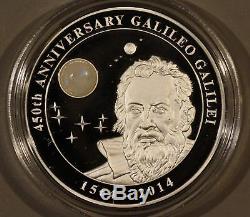
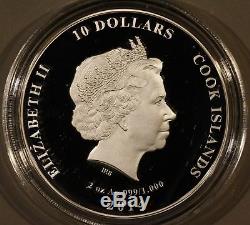
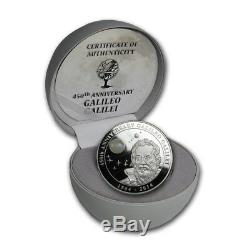
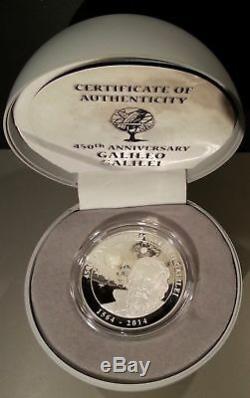
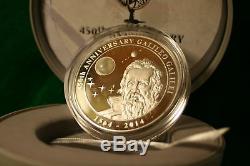

Galileo Galilei - 450th Anniversary of Birth. 2 oz - PF 70 ULTRA CAMEO - NGC Coin - with a very popular Brown Label - with the Original Government Packaging - MINTAGE = 999!!!!! SUPER RARE AND BEAUTIFUL COIN!!! THIS COIN IN PF 70 ULTRA CAMEO GRADE IS EXTREMELY RARE!!! THERE ARE ONLY 16 COINS EXIST WORLDWIDE IN THE HIGHEST POSSIBLE GRADE!!! 2 oz - this coin is struck in a stunning proof finish and is in the highest possible grade - PF 70 ULTRA CAMEO (PF is Proof Finish).
This coin has a l. Imited mintage of only 999 coins worldwide, making them very collectible for both coin collectors as well as. Is an absolute stunning work of numismatic art and a true collectible for the ages. Additionally, a very popular Brown.
From NGC is present on this coin. And the use of the moon stone on the entire obverse, this coin presents a dazzling image for the ages.
This amazing pure silver coin. With large 50 millimeter diameter , authentic moon stone insert , proof finish along with the. 999 silver design with highest minting craftsmanship. This coin is very unique in that it has. With an Authentic Moon Stone.
Mbedded on the obverse of the coin along with the fact that this coin is designed in. Ssued as legal tender under the Government of Cook Islands this coin is meticulously struck by the. In a three-dimensional proof finish with high relief design and with a mirror background on a stunning pure silver coin is minted from. 999-fine silver and is limited to a.Mintage of just 999 coins. And this example has been graded a perfect. The highest possible grade from NGC!!
This amazing 99,9% pure silver coin features multiple technologies to bring out the stunning beauty of. Struck in the incredible proof finish with the incredible high relief design. This coin is housed in a Very Large. Is the same technology that is used for the encapsulation and protection of some of the greatest coins today, including the Smithsonian Institution.
His coin presents a rare opportunity to view superb engraving skills of the. The use of multiple finishes for this latest coin series provides an added depth and further showcase the combined craftsmanship and artistry that have produced this stunning coin design and a brand new coin concept. Furthermore, this coin has been c.
From the Mayer Mint for over four years due to its immense popularity and its stunning design!! Contains a portrait of Galileo looking into a sky featuring the moon, some stars, and the then known solar system. The coin has the moon replaced with a piece of authentic moon stone along with the inscription - 450th ANNIVERSARY GALILEO GALILEI - encircles this design. The most interesting item about this design however, is the authentic Moon Stone located at the top left side of this coin and makes this coin a unique masterpiece.This is a stunning design of engraving artistry and fantastic art work like no other. Contains the profile of Queen Elizabeth II with the country of origin. Located on the right side of this design.
And the denomination - 10 DOLLARS - depicted at the top of this coin. The amount and purity of silver - 2 oz Ag 999 - along with the year-date - 2014 - are located at the bottom of this design. For this coin is serrated. Is securely protected in a Very Large.
The same technology that is used for the protection of some of the greatest coins in the world today. Additionally, a very popular Brown Label is present on this coin - the NGC label provides further guarantee of the coin's weight, purity, and overall quality - adding a factor of collectability to this unique coin. Included with this super rare coin is the Original Government Packaging (OGP) - this. Coin comes with the presentation packaging like no other. An absolutely stunning representation of the moon in this packaging complements this coin perfectly. The original white card-board outer case houses the deluxe moon-shaped presentation box. The original bag to protect the moon-shaped presentation box is included along with the original coin capsule. Additionally, this packaging contains individually numbered Certificate of Authenticity the certificate is entirely in English - the official language of. The Certificate of Authenticity states that the authority of the Government of the Cook Islands certifies that this coin is. And is guaranteed to match the standards of fineness and weight set down in the specification. All of this makes this coin and packaging an ideal gift for any coin collector and is a. Truly magnificent work of art. Galileo Galilei (15 February, 1564 - 8 January, 1642), was an Italian astronomer, physicist, mathematician, engineer, and philosopher who played a major role in the scientific revolution during the Renaissance. He is widely heralded as one of the greatest scientists of all time. His achievements include improvements to the telescope and consequent astronomical observations and support for Copernicanism.Galileo has been called the "father of modern observational astronomy", the "father of modern physics", the "father of science", and "the father of modern science". Galileo Galilei's contributions to observational astronomy include the telescopic confirmation of the phases of Venus, the discovery of the four largest satellites of Jupiter (named the Galilean moons in his honor), and the observation and analysis of sunspots. Galileo also worked in applied science and technology, inventing an improved military compass and other instruments. Galileo made original contributions to the science of motion through an innovative combination of experiment and mathematics. More typical of science at the time were the qualitative studies of William Gilbert, on magnetism and electricity.
Galileo's father, Vincenzo Galilei, a music theorist, had performed experiments establishing perhaps the oldest known non-linear relation in physics: for a stretched string, the pitch varies as the square root of the tension. These observations lay within the framework of the Pythagorean tradition of music, well-known to instrument makers, which included the fact that subdividing a string by a whole number produces a harmonious scale. Thus, a limited amount of mathematics had long related music and physical science, and young Galileo could see his own father's observations expand on that tradition.
Galileo was one of the first modern thinkers to clearly state that the laws of nature are mathematical. In The Assayer he wrote Philosophy is written in this grand book, the universe...
It is written in the language of mathematics, and its characters are triangles, circles, and other geometric figures.... His mathematical analyses are a further development of a tradition employed by late scholastic natural philosophers, which Galileo learned when he studied philosophy.His work marked another step towards the eventual separation of science from both philosophy and religion; a major development in human thought. He was often willing to change his views in accordance with observation.
In order to perform his experiments, Galileo had to set up standards of length and time, so that measurements made on different days and in different laboratories could be compared in a reproducible fashion. This provided a reliable foundation on which to confirm mathematical laws using inductive reasoning. Galileo showed a modern appreciation for the proper relationship between mathematics, theoretical physics, and experimental physics. He understood the parabola, both in terms of conic sections and in terms of the ordinate (y) varying as the square of the abscissa (x).
Galilei further asserted that the parabola was the theoretically ideal trajectory of a uniformly accelerated projectile in the absence of friction and other disturbances. He conceded that there are limits to the validity of this theory, noting on theoretical grounds that a projectile trajectory of a size comparable to that of the Earth could not possibly be a parabola, but he nevertheless maintained that for distances up to the range of the artillery of his day, the deviation of a projectile's trajectory from a parabola would be only very slight. Galileo's theoretical and experimental work on the motions of bodies, along with the largely independent work of Kepler and René Descartes, was a precursor of the classical mechanics developed by Sir Isaac Newton. Galileo conducted several experiments with pendulums. It is popularly believed (thanks to the biography by Vincenzo Viviani) that these began by watching the swings of the bronze chandelier in the cathedral of.
Using his pulse as a timer. Later experiments are described in his Two New Sciences. Galileo claimed that a simple pendulum is isochronous, i. That its swings always take the same amount of time, independently of the amplitude. In fact, this is only approximately true, as was discovered by Christian Huygens.Galileo also found that the square of the period varies directly with the length of the pendulum. Galileo's son, Vincenzo, sketched a clock based on his father's theories in 1642. The clock was never built and, because of the large swings required by its verge escapement, would have been a poor timekeeper. Galileo is lesser known for, yet still credited with, being one of the first to understand sound frequency.
By scraping a chisel at different speeds, he linked the pitch of the sound produced to the spacing of the chisel's skips, a measure of frequency. In 1638, Galileo described an experimental method to measure the speed of light by arranging that two observers, each having lanterns equipped with shutters, observe each other's lanterns at some distance.The first observer opens the shutter of his lamp, and, the second, upon seeing the light, immediately opens the shutter of his own lantern. The time between the first observer's opening his shutter and seeing the light from the second observer's lamp indicates the time it takes light to travel back and forth between the two observers. Galileo reported that when he tried this at a distance of less than a mile, he was unable to determine whether or not the light appeared instantaneously. Sometime between Galileo's death and 1667, the members of the Florentine Accademia del Cimento repeated the experiment over a distance of about a mile and obtained a similarly inconclusive result.
We now know that the speed of light is far too fast to be measured by such methods (with human shutter-openers on Earth). This coin is of extreme unbelievable rarity due to its limited low worldwide mintage of just 999 coins and its super high popularity due to the subject matter being. Additionally this coin having the Proof Finish with stunning High Relief Design combined with Two Ounces of Pure. With the highest possible grade of PF 70 ULTRA CAMEO and. Population For This Coin = 16 with a very popular Brown.And a Very Large Secure Holder. From NGC and with the Original Government Packaging - all together makes this coin and packaging set of ULTIMATE SUPER RARITY!! This coin never appears for sale on the open market and of supreme rarity in perfect grade - hence forth the ultimately low population.
Numismatic Guarantee Corporation (NGC) has graded this coin PF 70 ULTRA CAMEO (PF is Proof Finish). Certified at Proof 70 Ultra Cameo grade, the Numismatic Guaranty Company guarantees that this coin has no post-production imperfections at five times the magnification. The Authenticity and The Grade of this coin are guaranteed!! The population of this coin as of September 6, 2018. His is an extremely limited and extremely rare coin and packaging set!!Technical Specifications for This Coin. Obverse Finish: High Relief Proof.
Special Features: High Relief Design. Special Features: Very Rare Moon Stone Insert. Fineness: 0.999 = 99.9%. Original Packaging: White Outer Protective Box. Original Packaging: Original Coin Capsule.
For this item, within the continental. Furthermore, for this item I include. The item "2014 Cook Islands Silver $10 Galileo Galilei Anniversary PF70 UC NGC Coin" is in sale since Friday, April 5, 2019. This item is in the category "Coins & Paper Money\Coins\ World\Australia & Oceania\South Pacific".The seller is "coinmaestro" and is located in Maineville, Ohio. This item can be shipped to United States, Canada, United Kingdom, Denmark, Romania, Slovakia, Bulgaria, Czech republic, Finland, Hungary, Latvia, Lithuania, Malta, Estonia, Australia, Greece, Portugal, Cyprus, Slovenia, Japan, Sweden, South Korea, Indonesia, South africa, Belgium, France, Hong Kong, Ireland, Netherlands, Poland, Spain, Italy, Germany, Austria, Bahamas, Mexico, New Zealand, Philippines, Singapore, Norway, Saudi arabia, United arab emirates, Bahrain, Croatia, Malaysia, Chile, Colombia, Costa rica, Panama, Trinidad and tobago, Guatemala, Honduras, Jamaica, Bangladesh, Ecuador, Egypt, Guadeloupe, Macao, Peru, Pakistan, Paraguay, Reunion, Viet nam, Uruguay.
- Year: 2014
- Grade: PROOF 70 ULTRA CAMEO
- Certification Number: 4262854-011
- Country/Region of Manufacture: Cook Islands
- Circulated/Uncirculated: Uncirculated PF 70
- Certification: NGC
- Composition: Pure Silver

